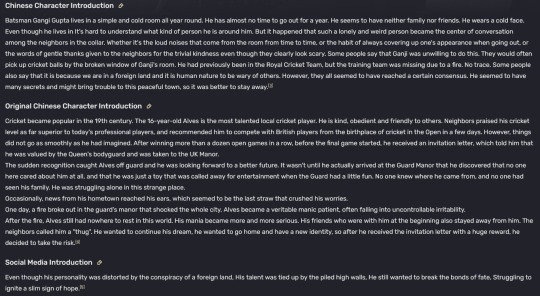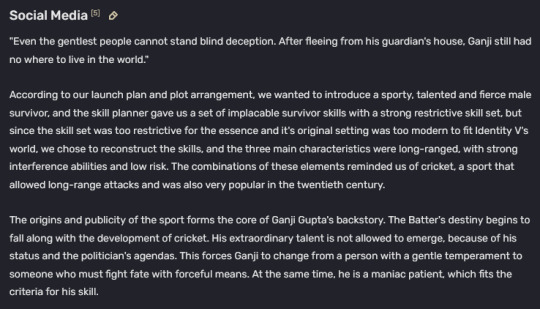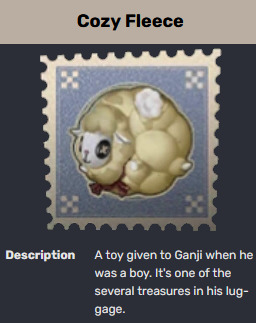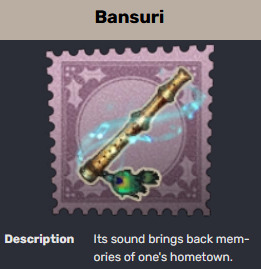#indian game development companies
Explore tagged Tumblr posts
Text
The metaverse is rapidly becoming a cornerstone of the digital future, and Simulanis, an Indian technology company, stands at the forefront of this transformation. As a pioneer in augmented reality (AR), virtual reality (VR), and mixed reality (MR), Simulanis is shaping the metaverse's integration into various industries. From education to healthcare, its innovative solutions are building immersive environments that redefine interaction, learning, and productivity For more information about metaverse development company , please visit the official Simulanis Solutions website: simulanis.com
#Metaverse companies in India#Indian metaverse startups#Virtual reality companies in India#Metaverse development India#AR VR companies in India#India metaverse solutions#India virtual space companies#Metaverse technology India#NFT companies in India#Virtual world startups India#Indian metaverse industry#Metaverse services India#Augmented reality companies India#Indian blockchain metaverse companies#Metaverse and blockchain India#VR development companies India#Metaverse apps in India#Metaverse innovation India#Virtual gaming companies India#Indian metaverse platform#Digital twin companies India#Metaverse partnerships India#Metaverse creators India#Virtual reality software India#Metaverse agency India#VR content creators India#Metaverse entertainment India#Indian digital experience companies#Metaverse investment India#XR technology companies India
1 note
·
View note
Text
Analysis of Ganji Gupta

Ganji was born in India during a time when Britain still ruled over it.

Britain came to India after a sea route connecting Europe to India was found, and Britain initially came due to the economic prospects of trade, but eventually this turned into the desire to acquire territory.
The British presence in India began with the establishment of the British East India Company (the British government having no authority over them at this time). Initially, the focus was trade and acquiring goods such as silk, cotton, spices, and more. Trading posts were established and British communities developed, but eventually they started to meddle in Indian politics and transformed from a trading company to a ruling one. It was at this point that the British attitude towards Indians degenerated (a sense of superiority vs inferiority formed, biased views regarding non-western cultures arose, British disdain increased, and so on). Racism, frustration from the British forcing their own way of doing things (including the English language) on them, policies benefiting the British, and so on contributed to the Indian Rebellion of 1857 (aka Revolt of 1857, First War of Independence, or Sepoy Mutiny).
As a result of this rebellion, the British East India Company was replaced by the British Raj, which was when the British Government took direct control from the East India Company, with Queen Victoria later proclaimed Empress of India. Britain continued to focus on profit and change beneficial to themselves, which led to subjugation and exploitation, and their views of Indians did not improve (still viewed themselves as superior, believed in stereotypes as well as believed Indians were in need of British guidance and governance to civilize them and bring them modernity).
This background is important for Ganji as it is clear this is what he experienced, especially due to Ganji’s 1st letter.
Ganji we know grew up with a talent for cricket, which was the “British national sport”.

His 2nd deduction implies he was a “prodigy”, with many people who knew him recommending him to participate in the regions “open tournament”. We know from Ganji’s trailer that he received “Love, Happiness, Hope and Pride” from playing cricket, showing how much he enjoyed the sport and how much it meant to him.


According to this same deduction, combined with Ganji’s backstory, we knew he was a “kind, obedient, and friendly” person, “mild-mannered” (aka gentle and not given to extremes of emotion, which is curious considering later on in Ganji’s story), quiet, and well-behaved. One of Ganji’s backstories states this event (where he was recommended to participate in the Open) took place when he was 16 years old.
During this competition, we know he was skilled enough to earn 12 consecutive wins. The next game after those 12 was a semi-final with the British Royal team. It does not say if Ganji won or lost that match, nor if he won the competition in general, but we do know he was skilled enough to receive an invitation from the Royal team to join them and an offer to help him train. As the deduction uses the word “exception” and applauds him for his performance, I’m assuming he did manage to at least defeat the British team and could’ve won the competition too, but it’s impossible to say for sure right now.


We do know that Ganji saw this invitation as a “good chance” and he “looked forward to a better future”. As a result, he left India with the British Royal team, where he stayed at the Queen’s Guard’s manor. Unfortunately for Ganji, it isn’t until he has arrived that he realizes the truth: “he discovered that no one here cared about him at all, and that he was just a toy that was called away for entertainment when the Guard had a little fun. No one knew where he came from, and no one had seen his family. He was struggling alone in this strange place”.
This was echoed in Ganji’s trailer, which says: “Yet when I was brought here I finally realized, These gentlemen simply needed a proper toy to play with. The funny thing is they were far from gentlemanly themselves. All they longed for were our submission and servitude”.


The terms “submission and servitude” tell us how Ganji was treated while in Britain at the Queen’s Guard’s manor. This is further emphasized by Ganji’s deduction 5, which states Ganji was only given 1 day to train, while 2 others (Oliver and Willie) were given 3 days to train. As that deduction says, despite how Ganji hoped for a better future from this opportunity, the “other sided” ended up only being a “mirage”.

Considering Ganji’s earlier invitation and how he is now being treated combined with only being given 1 training day, it seems the British didn’t want Ganji to be outstanding, which potentially could relate to the feelings of superiority discussed earlier. They didn’t want to feel inferior to someone like Ganji, and thus could further explain why they didn’t give him much training time. In the trailer, we see him picking up balls, and if this was all he was allowed to do, that’d further hurt his ability to train and improve. Lastly, Ganji was only allowed to train on Sundays, and back then, this was seen in Britain as a day of rest, when people didn’t work. This could’ve included cricket as well (there are instances of people being prosecuted for playing cricket on Sunday), which shows how much the Royal team tried to hinder Ganji’s ability to train, meaning he likely wasn’t being trained very professionally.
(If the room we see Ganji in before the fire in his trailer is the one he was given upon arriving at the manor, the state of the room could further show how the Royal Team felt about Ganji. The only identifiable items in the room are the cricket ball, as cricket is what he enjoys, and a blurry picture that we can see Ganji in, which could potentially have been of his home and thus ties to his desire to return to it.)

This fits with Ganji’s design notes which say “his social status and the agenda of politicians did not allow him to have obvious extraordinary talent”. It is because of this the design notes say Ganji’s gentle personality was forced to change into “a personality that takes strong measures to fight against fate”. (It is also right after this that it mentions Ganji being “manic”.)

Going to Ganji’s 1st letter, it further reveals how people thought and felt about Ganji and others like him. The part where the author says they need to “take the lead so that the rest of us may get the chance to educate the foolish” fits with how we earlier discussed the British felt they had to govern and civilize the people of India for their own good. This is emphasized with how later the letter says “If it weren't for your insight, he would have spent his life in the mud without ever being touched by the empire's light” and Ganji getting “the chance to lead a civilized life”.

This letter describes Ganji as a “gift” with his “only desirable qualities” being his “average cricket skills and humble personality”. Their sense of superiority is clear hear considering they call Ganji’s skills “average”, yet we know he was talented considering he at least managed to receive 12 consecutive wins in the competition, while the comment about Ganji being “humble” could tie in to how Ganji in his trailer says they just wanted “our submission and servitude”.
Despite how badly Ganji was treated, the one exception was the son of the owner of the Queen’s Guard’s manor. We know he was friendly to Ganji based on Ganji’s deduction 6, which is title “relieved” and shows that the kid thought Ganji was “brilliant” and asked Ganji to play with him. It is possible Ganji is the one who feels “relieved”, and that could be due to actually finding someone friendly in this place. In the JP and CN versions, it potentially has the kid use the term “big brother” for Ganji, so altogether, the kid was likely being honest about his feeling regarding Ganji’s skills and honestly just wanting a real playmate (rather than a toy like the others saw Ganji as).

In this same deduction, it mentions a “well-made board” that has Ganji’s name carved in it. As this is the deduction that involves the son of the manor owner of the Queen’s Guard, it is possible this board was a gift from that kid, and that board may have actually been a bat for cricket.
Going back to Ganji’s 1st letter, it mentions a “Duke Elgin” and a “Viscount”. Based on the mention of “the Viscount’s prominent father” and how this Viscount “demanded” Ganji to “take classes with him instead of just playing cricket with him”, it’s possible the “Viscount” could be the son of the owner of the Queen’s Guard’s manor. We know this boy asked Ganji to play cricket with him due to how cool and talented he thought Ganji was, so it could also fit he might also ask Ganji to take classes and spend other time with him. I’d like to imagine Ganji enjoyed spending time with the boy, as taking classes and playing cricket with him was likely much better than being treated as a toy by the others or languishing along in his poor room.
Ganji continues to play cricket, despite his anger, though he does form a relationship with this boy. If Ganji was 16 during the Open when he was invited to join the Royal Team, and Ganji is at least 21 in game (as he can drink Demi’s dovlin), he was likely subjected to the mistreatment of the Royal Team and owner of the Queen’s Guard’s manor for a fair number of years at least. As we know, he was never able to meet his family while he was at that manor and he was forced to “struggle alone in this strange place”. The “last straw” came one day when he received news “bad news” about his hometown, with his deduction 7 saying he’d received a letter saying “Go home and save them!”

It is soon after this that a fire breaks out and burns down the manor of the Queen’s Guard. The only survivor was the owner’s son and Ganji.

This is also the same time that in his backstory trailer it says “Stop being nice to everyone. I need a new identity. I want to go home. Perhaps that is the only place where there's still hope”.

This matches with Ganji’s last deduction, which is “a letter to home” that he wrote to his mother, saying that “everything’s fine with me. I’m coming home soon”.

Right after the fire starts in one of his backstories, it says Ganji became a “manic patient, often falling into uncontrollable irritability”, so it seems the fire and around this time is when he is first said to be manic. His deduction 9 has a diagnosis saying “Mania, easily irritated. Avoid looking at fire. Suggest locking all windows and doors and staying at home alone”. It is because of his worsening mania that is says people stayed away from him and called him a “thug”, but Ganji only cared about going home.

Once again returning to Ganji’s 1st letter, the end of it talks about getting info on Ganji’s “hometown and the extraordinary spice extraction”. The mention of spices fits our earlier discussion on Britain’s interest in India in part for its spices. This info about Ganji’s home and spice extraction is apparently helpful to whoever this “sir” is and an “upcoming mission” he will be going on. This same “sir” is apparently someone responsible for the idea to bring Ganji to England (though for now I’m thinking he isn’t the Queen’s Guard’s manor owner, who I think is the Viscount’s father).
Considering the talk about Ganji’s hometown and the obvious interest in its “spice extraction”, this could mean this “sir” is someone behind whatever “bad news” came from Ganji’s hometown, and likely the “bad news” and “upcoming mission” had to do with their clear interest in its spices. And if they wanted info on Ganji’s hometown, that could mean one of the few reasons they invited Ganji over was for that info so they could exploit his hometown for the “spice extraction”.
(One side note about Ganji’s 1st letter, but in the CN and JP versions, it says this “Sir” is someone who is recovering their health in “Delhi”, which further shows it’s not the owner of the Queen’s Guard’s manor, who we know was in Britain. It’s possible, if this is someone capable of going on missions and is mentioned regarding “we need… people like you to take the lead” that this “sir” is someone higher up in the government regarding rule of India, who could order a mission to Ganji’s home for it’s “spice extraction”).
Next is Ganji’s 2nd letter, which unlike his 1st (which happens before the fire) his 2nd happens after the fire. We hear he tried to board a freighter. Likely he was attempting to stowaway to return home, but he was caught and taken away by someone working for Duke Elgin. Ganji was placed in a detention center, where he was examined. They mention a “strange scar on his forehead”, which potentially came from the fire that burned down the Queen’s Guard’s manor. We do see Ganji with the owner’s son while the fire burns the manor, so if he had to go in to rescue him, that could have been when.

Considering how they say Ganji, besides his scar, seems “as strong as ever” to me kind of feels like they’re still talking about him like an object or one of their possessions.
After this, the letter mentions how Ganji would be “quiet during the day” but would go “mad” at night, with him “either holding his head between his hands while slamming it against the wall with a pained expression plastered across his face or attempted to snatch the candles used by the guards to keep the place lit up. He only settled down once we locked him in the darkness of the dungeon. But once the next day arrived, he was back to normal again”. It was due to this behavior that the author states he went to purchase “strong sedatives” (to be used on Ganji if he went out of control). During this time while the author was away, Ganji was able to escape despite the guards around him. Despite this, the author believes Ganji will return as they still had several of his possessions, including “medical records, an invitation, and that "treasure" of his.
It says the part with the signature had been “burned off”. If Ganji was messing with candle fire while in the detention center, it’s possible he did something similar to this letter if he got ahold of it (unless it’s nothing important).
The mentioned “treasure” is likely the note from home that reads “Come home, child”. Considering it says “child”, there’s a chance this could’ve been written by his mother. We know Ganji’s written to her himself before, so him receiving correspondence from her would make sense.
Another treasure we know Ganji owns is his accessory Cozy Fleece, which is a sheep toy “given to Ganji when he was young” and said to be “one of the several treasures in his luggage”. This was likely another item given to Ganji by his mother, when he was still home, and thus why he treasures it. Another potential treasure could be Ganji’s bansuri accessory, which has the description that mentions its music helps to recall his hometown.


As for the medical records, it says that the patient is suffering “severe homesickness” and displays “impulsive behavior during times of extreme depression or anxiety”. This means that Ganji’s “mania” is caused by his “severe homesickness” in moments when he’s suffering from “extreme depression or anxiety”. That could mean, with Ganji already being homesick for years before the day the fire started, Ganji’s “last straw” when he received bad news about his hometown now makes sense why the fire likely started then. That “bad news” triggered his anxiety and severe homesickness, depressed him when he realized he was stuck at this manor with no quick way home, before then making him impulsive and “manic” in his desire to go home as soon as possible. Whether or not it was on purpose or an accident, it is possible one of his “impulses” resulted in the fire starting, or a confrontation that triggered his irritation causes it to accidentally begin. Maybe a bit of sanity returned to him afterwards, and that could be when he rescued the boy as we see him with the boy during the fire in Ganji’s trailer. But for now, information is scant on the specifics of this event.
Potentially after escaping detainment could be when we see him living by himself like in his other backstories. It’s possible he was in hiding from those that had captured him. We don’t know for sure whether he returned to them for his treasure (it’s possible with how important his note from his mom likely was). We know from Ganji’s backstory that it says he “lived in a cold room with little furniture for years” and “seldom stepped outside during the year”. He had no friends, always looked solemn, and people found it “difficult to get to know him”. Ganji is described as “peculiar and lonely”, and someone his neighbors “loved to gossip about”.
His backstory mentions “random loud noises coming from his room”, which could tie to the behavior he displayed at night in the detention center, when he’d hit his head against a wall.
Regarding Ganji hiding in his room all the time, this connects back to his deduction 9, the diagnosis that suggested “locking all windows and doors and staying at home alone”.
The part about “avoid looking at fire” implies, whether or not he did it and whether it was on purpose or accident, it implies he’d been deeply affected by the fire that burned down the manor. Maybe because of all the feelings (and irritation) he had from how long he spent there, being mistreated and never being allowed to train. Maybe because of the boy he’d formed a relationship too and how this fire took away his home and family, just like Ganji was without his home and family. Maybe any conflict he had if he was somewhat responsible, whether accidentally or on purpose, as his trailer does mention wanting those “gentlemen to repent for their sins” but also because this was a place he’d had such high hopes for regarding his future and now it’s turning to ashes, as well as was a place he’d suffered alone, away from his family, for a long time, but more conflict because Ganji was deep down still a “kind” person (and maybe regretted not saving more people, or regretted if he had a fit of anger and its consequences that day that causes all these events). Just another boy, like the son of the owner of the Queen’s Guard crying at the sight of his home on fire, that was crying out for his family and home as it was threatened or attacked but Ganji unable to do anything about it.
The backstory continues by saying he kept his appearance “hidden” whenever he went out, which could relate to if he was in hiding from the people who’ve been trying to capture him in his letters, or to the mistreatment he potentially receives if people knew where he was from, or to hide the scars on his face from people if he knew how they’d react upon seeing it (as they did describe his face as “horrifying”). It also fits with how his trailer said he needed a “new identity”.
Despite how they treated him, Ganji was said to give “softly spoken words of appreciation to the neighbors’ trivial kindness”, which seems to connect to Ganji’s original personality (as he was described as kind, friendly, and mild-mannered before he came to Britain).
Others debated the reason for Ganji’s behavior, suggesting “regret” (tied to the fire that ended his training with the Royal Team, as other people wouldn’t know the full truth about his feelings towards the Royal Team) or “cautiousness” (from living in a foreign country). Unfortunately for Ganji, everyone decided that Ganji had “a lot of secrets” and “might bring trouble to the town and decided to stay away from him”.
The last thing we hear about Ganji is he still dreamt of returning home, and eventually received an invitation from the manor, offering a “huge reward”, enough for Ganji to use to go home, and he “decided to take the risk”.
Side note regarding Duke Elgin.
I couldn’t find any “Duke” Elgin, but I did find an “Earl” of Elgin. The 9th Earl of Elgin, Victor Bruce, was the Viceroy of India.
I don’t think this is the exact same “Duke Elgin” but it could be a basis for the character (for Netease when designing this).
These were individuals appointed by the British monarch. They represented the British government in India and exercised authority over British India on behalf of the British crown. Victor Bruce served as Viceroy during 1894-1899m which was a particularly troubled period in Indi’s history, and his tenure was not seen as a successful one. During his administration, there was economic and social unrest, a famine, bubonic plague, and the Tirah campaign (Afridi Frontier Rising). This campaign took place in Northwest India and involved the British seeking to restore control over the area after an uprising occurred (with 1 of the challenges they faced being the mountainous terrain).
I don’t think this is exactly where Ganji is from, but this event, as well as all the other issues occurring at the time, could relate to or be a sort of basis (to Netease) for whatever did actually happen to Ganji’s hometown.
Apparently the “bansuri” is a flute connected to north Indian music (with the venu being connected to the south), which could mean (with how the Tirah Campaign happened in the Northwest) Ganji could be from somewhere in the North part of India.
#idv#identity v#ganji gupta#batter#idv ganji#identity v ganji#idv batter#identity v batter#sirenjose analyses and theories
86 notes
·
View notes
Text
Last Monday of the Week 2024-11-11
Getting into situations
Listening: New job which means I have need for a quick and easy source of music that I can throw down on any device with internet while I figure out exactly where I draw the line on mixing personal music files with corporate hardware. Hence, soma.fm, a really good family of internet radio stations that I enjoy a lot.
There's several stations here but to call out ones I like in no particular order:
Beat Blender: Slower house music and electronica
Metal Detector: What it says on the tin, mixed metals
Sonic Universe: Weird jazz
Secret Agent: Normal jazz
SF 10-33: The San Francisco emergency radio broadcast channel mixed with ambient music
Vaporwaves: Look we all have to get stupid sometime
Watching: Movie Night was also a sort of belated Diwali Night because a friend of mine has been getting extremely into indian food, so we watched "Sita Sings the Blues", an 82 minute, Creative Commons, mostly one-woman animation project that is a retelling of the Ramayana and also a breakup jukebox jazz musical.
youtube
There's about 30 minutes of a decent movie in here and another 15-20 minutes of the breakup part that would be hard to cut since it's the reason it exists. It's an animation from 2008 and you can see that it's exactly what it needs to be to run on one person who knows Flash reasonably well. The "blues" part is because there's numerous musical segments that use pre-existing 1920's jazz numbers to set the tone which reportedly cost the author tens of thousands of dollars to license, and she's now a free culture advocate so this is how you get Cory Doctorows I guess.
Is it good? I mean there's some really good parts. The legend is delivered in the form of three shadow puppets half-remembering the story to put it together which is very endearing in a Bill Wurtz History Of Japan kind of way. The amount of effort on display for 2008 is enormous. The concept is impressive, in that you found all these songs, but you could have probably cut the songs and got this down to a tight 40.
Reading: Work! Documentation! Learning so much about [REDACTED]. Very weird not working in an open source company again.
Also started The Book of All Skies on the metro the other day, and have gotten to the end of the first act. Compelling! Love an Egan, one of very few authors who can put a topology lesson into a book without it sucking ass.
Making: Made Gulab Jamun for movie night. From spreading my diwali cooking over more than three days I'm learning that actually this shit is easy if you don't try to cram it all into three days. I should make this stuff more often.
Playing: Poking and fiddling with things a little. Still not in the headspace to pick up a full game again. Once I have a schedule I can get back into video games but when I don't have a schedule that includes video games.
Tools and Equipment: Keyd is the new-ish hotness for client-side remapping of keyboard keys. It's not quite a custom build, but it's close.
Allows you to get 99% of the way to whatever zany custom mapping you want under Linux with fairly universal coverage and minimal faff in a very compact and manageable package.
8 notes
·
View notes
Text
ARC Review of Marriage and Masti by Nisha Sharma

Rating: 4/5 Heat Level: 3.5/5 Pub Date: August 27th
Premise:
A Twelfth Night-inspired romcom; Veera Mathur drunkenly marries her friend and crush Deepak Datta, and they agree to stay married as platonic friends until they meet their respective career goals.
My review:
Nisha Sharma finished her If Shakespeare Were An Auntie series strong with a friends-to-lovers romance done RIGHT. It has the perfect amount of pining and angst without veering into pathetic territory, and the way Deepak and Veera's romance develops post-marriage feels so natural and QUITE swoony.
Veera's in a bad place after being forced out of her family business by her own dad before they merge with Deepak's company. She's aimless and trying to raise capital with her twin sister for their next venture when she's yacht-wrecked in Goa. Enter Deepak, who was juuuuust dumped by his influencer fiancée via "get-ready-with-me" video (I did laugh; THERE'S your "com" in the romcom) and he rescues Veera, except they have a few too many and wake up married the next morning.
Here's the thing: Veera and Deepak have a history. Their friend groups merged a couple years back and they really hit it off, something we see via flashback text message conversations (similar to Tastes Like Shakkar which I loved), and you really see how Veera developed feelings for Deepak, as well as her hurt when she found out Deepak was engaged to someone else without telling her. Somewhere along the way, probably after his engagement, Deepak realizes he has feelings for Veera too and he takes the opportunity to play the long game after their accidental marriage. I like how neither Deepak nor Veera are in a place where they're like, super tragic about their love being unrequited which is how a lot of friends-to-lovers romances don't end up working for me. They never take it out on the other person, and though Veera especially hesitates even after they have sex and Deepak has kind of made his feelings known, it doesn't feel contrived.
I think Indian weddings are seen both in India and abroad as this enormous to-do (if recent events are any indication) and sort of the be-all-end-all, but there is so much more to a marriage than the wedding. And because Veera and Deepak basically elope, we don't get the wedding and instead, we see all these lovely, meaningful post-marriage Indian (specifically Hindu-Punjabi) traditions like the Aunties blessing their home and the Grihapravesha pooja to welcome Veera to Deepak's family home. And some of these moments are so so romantic— I DIED when Deepak pleats Veera's dupatta and helps her with her baliyan earrings before their wedding reception, and the way they observe, but also subvert the patriarchal tradition of Karva Chauth (where married women fast for their husband's well-being) in such a sweet way.
A couple other things worth noting— there is a lot of boardroom drama; the plot is centered around Deepak getting enough votes to become CEO, and Veera finding closure and moving forward after being shunted out of her family's company by her own dad. And a part of that, interestingly, is going no-contact with a family member, something that is still looked down upon in =South Asian communities, but I appreciate the nuanced way it was handled in this book, and by the end, you can see Veera is 100% valid for doing what she does. I also liked how the story deals with Veera feeling like the odd one out after both her friends coupled off which is very relatable.
The sex:
Deepak has strong "don't worry baby I'll take care of you" energy and I have to say, I'm a fan. It starts off strong with a sleepy sex moment (HOT; I love when two characters are just too exhausted to not give into their impulses), but my favorite scene is definitely before their belated wedding reception, and Veera is feeling anxious so she asks for "stress relief"— Obviously Deepak is more than happy to oblige, and there are so many details I loved, like the chime of her anklets against his back, and the way her lehenga is half off and exposing her partially. Again, Nisha Sharma is doing the most to eroticize Indian clothes and jewelry and I'm HERE for it.
There's also this mild brat/bossy dynamic which kind of peaks when Veera and Deepak go all the way the first time. It was surprising in a good way, and I just wish Nisha had expanded on it some more.
Overall:
Look, it's hard to find South Asian romances with this level of heat (and believe me, I've looked) and Nisha Sharma did a great job of interweaving the romance and culture in a really lovely way that I'd recommend to anyone looking for a romcom-esque romance novel.
Thank you to Avon Books and NetGalley for the advanced copy in exchange for my honest review.
#arc#arc review#netgalley#nisha sharma#contemporary romance#avon books#romance novels#desi tumblr#desiblr
8 notes
·
View notes
Text
DEEPALI NIBHANUPUDI (NAGARKAR)

Origin: krtrim (computational phantom)
Status: posthuman, piloting a standard Class-1B civilian 2028 CHOSHI-II vessel (modern Delhi variant) distributed by OURO
Nationality/Ethnicity: Indian, currently resides in southeast Britain. ORANGE color ID
Age: 33KR (date of genesis January 4th, 2019)
Occupation: simple electronics assembler for Loxton-Duchêne
About:
Deepali Nibhanupudi is the surrogate daughter of Mona Nibhanupudi, and goes by the alias Deepali Nagarkar to avoid association with him. She is considered the first and therefore oldest krtrim ever created.
Mona formally trained Deepali in kalaripayattu as a form of discipline throughout her youth. Though Class-1B civilian vessels only stand at five feet (152cm) tall and have smaller proportions than a human her height, she is a formidable threat with her extensive martial arts background. She is quick to think on her feet and highly observant. However, her timid and often pushover nature make her unassertive, and she only exercises violence if the situation is dire enough.
Deepali is quiet, and does not usually speak until spoken to. Her shyness gives her the appearance of stoicism, though in the presence of those she trusts, she is possesses a charming wit and bright personality. She is deeply loyal to those she cares about, even it means risking her own life. She enjoys painting, knit sweaters, and playing word games like Sudoku or Scrabble.
Background:
For what is believed to be sentimentality, Mona kept Deepali for himself shortly after creating her. While other krtrim were advertised as workers to be sold off to corporations, Deepali was raised like a human child. Despite her reserved personality in adulthood, Deepali was very mischievous in her youth, which created tension between her and Mona's strict parenting regimen. Though she expressed her desire to go out into society to make friends, Mona banned her from ever leaving his custody, and she grew to resent him as time passed. In the rare times he was present, Mona would either subject her to training or tests of her cognition. The rest of the time he was largely absent, often traveling for business related to OURO.
After his death in 2029, his estate was ceased by interpol, causing her to flee into the surrounding city. Upon entering the streets she was marked for repossession. She finds and befriends another krtrim named Viggy, a former rickshaw driver, who is also on the run after the company he worked for disposed of all its krtrim staff. Together they try to escape to Bangladesh, but are ultimately caught by OURO authorities. Viggy is killed, and Deepali attempts to commit suicide. She is captured before she can go through with it.
Upon learning of her connection with Mona, Deepali is spared from repossession and instead interrogated for information. Robopsychologist Dr. Emelie Yadavalli is assigned to probe her mind to see what she knows. Deepali’s mental health spirals as she’s questioned on her purpose and the validity of her memories, developing rapid onset magnetic actuator deviancy (ROMAD), also known as Corruption. When OURO concludes that she has nothing to offer them, they plan to retire her permanently, but Emelie decides to buy her vessel-hood out of pity. She rehabilitates her, and once the war is over, she allows her to live on her own devices in Europe.
For the next 10 years, Deepali works as a simple electronics assembler for OURO’s Auxiliary branch in southeast Britain. She lives in a small apartment on the outer edges of Auxiliary by the coast.
36 notes
·
View notes
Text
Accounting Outsourcing India: Why MAS LLP is Your Ideal Partner
In today's fast-paced business environment, companies are increasingly turning to accounting outsourcing as a strategic move to enhance efficiency, reduce costs, and focus on core business functions. India, with its vast pool of skilled professionals and cost-effective services, has emerged as a global hub for accounting outsourcing. MAS LLP is at the forefront of this trend, offering top-notch accounting outsourcing services that cater to the diverse needs of businesses worldwide. Why Choose Accounting Outsourcing India? Cost Efficiency: One of the most significant advantages of outsourcing accounting services to India is the substantial cost savings. Indian service providers offer high-quality services at a fraction of the cost compared to Western countries. This cost advantage allows businesses to allocate resources more effectively and invest in growth initiatives.

Access to Skilled Professionals: India boasts a vast talent pool of accountants, chartered accountants, and financial analysts. These professionals are well-versed in global accounting standards, ensuring that your financial records are accurate and compliant with international regulations. Focus on Core Business Activities: By outsourcing accounting functions, businesses can free up valuable time and resources. This allows management to focus on core business activities, such as strategic planning, marketing, and product development, which are essential for long-term success. Scalability and Flexibility: Outsourcing accounting services to India offers businesses the flexibility to scale up or down based on their needs. Whether you require full-time accounting support or specific services like payroll processing or tax filing, Indian outsourcing providers can tailor their offerings to suit your requirements. Why MAS LLP is the Right Choice for Accounting Outsourcing India MAS LLP has established itself as a leading provider of accounting outsourcing services in India. Here’s why partnering with MAS LLP can be a game-changer for your business: Comprehensive Service Offerings: MAS LLP provides a wide range of accounting services, including bookkeeping, payroll processing, tax preparation, financial reporting, and more. Their comprehensive service offerings ensure that all your accounting needs are met under one roof. Experienced Team: The team at MAS LLP consists of highly qualified professionals with years of experience in the accounting industry. Their expertise in handling complex accounting tasks ensures that your financial records are in safe hands. Advanced Technology: MAS LLP leverages the latest accounting software and technologies to deliver accurate and timely services. Their use of advanced tools ensures that your financial data is processed efficiently and securely. Customized Solutions: Understanding that every business is unique, MAS LLP offers customized accounting solutions tailored to your specific needs. Whether you’re a small business or a large corporation, they have the expertise to cater to your requirements. Commitment to Quality: MAS LLP is committed to delivering high-quality services that exceed client expectations. Their focus on accuracy, compliance, and timely delivery has earned them a reputation as a trusted partner in the accounting outsourcing industry. Conclusion In an increasingly competitive global market, outsourcing accounting functions to India is a strategic move that can provide significant benefits. With MAS LLP as your partner, you can rest assured that your accounting needs will be handled with the utmost professionalism and expertise. Whether you’re looking to reduce costs, improve efficiency, or focus on core business activities, MAS LLP offers the perfect solution for all your accounting outsourcing needs. For more information on how MAS LLP can assist your business with Accounting Outsourcing India, contact them today.
#accounting & bookkeeping services in india#businessregistration#chartered accountant#foreign companies registration in india#audit#income tax#auditor#taxation#ap management services
6 notes
·
View notes
Text
Skull and Bones - Misnomers
I kind of tuned out of Ubisoft's "quadruple-A" bloatfest the moment I realized that the scenario was hellbent on taking its analogy between the 1750s' trading companies in the Indian Ocean and modern megacorporations to the stupidest of all next levels imaginable.
See, the game performs one tiny historical travesty that I'd normally forgive, except every kid and their mother grows up learning that what helped to develop the Americas was a group of monopolies referred to as trading companies - not megacorps.
Megacorps are a new concept, historically speaking. I've also seen people confuse them with trusts, but they don't quite fit. Trusts are essentially company-centric unions, if I had to bastardise a concept, focused and designed to promote the companies operating a particular market and to serve their interests. They weren't monolithic. A trading company was a single entity, with the root of the misuse of the term "megacorporation" lying in the fact that trading companies had many similar concepts. Trading companies fostered their own company culture and identity, they had their own standing fleets and included ships designed in order to protect the trade assets sailing across the Indian Ocean and Caribbean.
Megacorporations, on the other hand, are conglomerates by necessity. They're symbiotic massings of smaller companies, granted some rights typically reserved for individuals out of the notion that what hurts the gestalt hurts the worker. There's reams of Leftist and Social-Democratic theory out there that proves this assertion is a crock of shit and hurts most workers. As we currently stand, megacorps do not yet have standing armies - thank God - and are yet to replace legislative bodies. Considering, the analogy Skull and Bones tries to make is incomplete, poorly expressed and misleading.
Pirates weren't Punk. Dig a little and you realize most of 'em wheeled and dealed with impunity, going from Corsair to Pirate and back and forth all depending on who paid the most.
6 notes
·
View notes
Note
Character Development Questions ask game
A simple 2 + 3. 😌
(for this ask game thing)
i hear i had a choice to do this for a/b!anthony and/or canon!anthony but lbr everyone knows canon!anthony (for these two questions esp (in hindsight i realised that some of the other questions listed might be interesting for canon!anthony bc they're kinda headcanon-ey)) and canon!anthony isn't really... mine per se, SO.
this is for a/b!anthony! :3
2. What is/was your character’s relationship with their mother like?
With Violet: I think he liked her, I mean he (atm) last saw her when he was 2 years old. And he's her firstborn, so. She probably spoiled him a healthy amount :P But then when Benedict was born, she probably paid him more attention for a while so Anthony went through a (imo) very natural jealous stage
ETA: after he meets her again and she realises who he is, I think she's just gonna smotherrrr him with affection and not want to let him out of her sight, and he's just gonna be like, uhhhh (and... etc, lost as well, and... lots more things I haven't considered yet bc i'm not up to it. but he's ... probably gonna be so angry at his adoptive parents for a while? but he also doesn't really have anyone to turn to, exactly? like, he hardly knows violet, and him and benedict are... also going through it...... in a different way.................. lmao)
With his adoptive mum... who iirc I am calling Jo??? I haven't even written her yet bc I haven't got up to her or written the flashbacks haha: I think he really loves her. And she really loves him. (This is before he finds out that they (she and his adoptive dad) kinda hid him from his real parents.)
Ummm I think she took care of him really well when they were on the ship, she was the cook so... I think she had him in the kitchen with her, and once he stopped being upset about his real mum and dad/forgot about them, he started helping out. And his mum also sorta picked up recipes from the different countries they travelled to and started cooking different cuisines because Anthony tried food from whatever country they docked in and then decided that he wanted more of that when they left (e.g. he likes Indian food).
I think the day he forgot his real parents and called her mum, she would've been really happy. (This is after they tried to return him to Edmund, but Edmund got the note too late of where the ship would be docking on the way to finally leaving England for a few years, so from Anthony and his adoptive parents' perspective, Edmund didn't want him because he didn't show up, so his adoptive parents were quite angry/upset for him/'well we'll take care of him then!' and Anthony ofc was distraught when Edmund didn't turn up to take him home (because it's just further proof that they didn't want him/preferred his new baby brother (happily, he kinda forgets this trauma, but he gains a fear of abandonment :P)))
I think Anthony finds out fairly soon that his mum is trans (like when you're all sleeping in one big room (I presume) in hammocks, and Anthony is probably sharing a hammock with his mum, welllll) but he doesn't realise until he's 5 or 6 that if both his (adoptive) parents are biologically male, then he must be adopted
Ummm. When he realises that his parents have this goal of saving enough money so that they can stay in England permanently and have a shop (that sells art supplies), he starts working on the ship (when he's about 7 i think)
(Somewhere along the way, the art shop idea evolves... because they're trying to make it profitable, and Anthony's adoptive dad is an artist (painter (for the ships) originally) so it becomes a publishing company for children's books mainly, with illustrations by his dad)
His mum is good with money. And hmm maaaybe with languages too since they're translating some of the fairytales from different countries by themselves. But I'm not sure about that yet. I haven't really thought about it because I haven't gotten up to it :P But yeah his mum IS good with money/business-minded/kinda ends up running the shop
Iirc I think I said somewhere in one of the earlier chapters that she's the best out of the three of them re sailing/rowing and Anthony learnt both of those things from her (and from other people on the ship ofc)
At some point when they're back in England, his mum sees the ~missing posters for Anthony Bridgerton with a reward if he's found, and she (and his dad) know that he's a Bridgerton (because 2y/o Anthony told them) but ofc Anthony has since forgotten. And since there's a monetary reward for finding Anthony, plus Edmund didn't show up all those years ago, his mum's just like, we are NOT giving up our son for money/to people who don't even really want him!!!
Later on, Anthony starts asking questions about his biological parents, and his mum says they adopted him from an orphanage in London as a baby and that his real parents didn't want him (1/3 true (from their perspective) lol). And later when they're living in England permanently and Anthony starts looking for info on his biological parents in the orphanages, she gets kinda pissed off/scared about it/scared he'll find out he's a Bridgerton somehow, so Anthony learns not to tell her about it (or his dad) and continues looking in secret
Re Anthony going to Harrow, I... think it was probably his mum who was very determined that he get a good education. Like, to her, education is important, and she kinda instilled that in Anthony. (I think Anthony must've had some lessons from someone educated on the ship, maybe a passenger, orrrr... huh idk, HUHHHH no i just had a thought, maybe his mum is a bit more on the middle/upper middle class side than working class?? but she (well, probably he* at that point) wanted to marry a working class guy so her family disowned her, maybe... ANYWAY (that could work actually!! Basically I need Anthony attending Harrow on a scholarship))
(just gonna say that upper middle class people (or middle class people) from places that aren't london/kent/(bath?) don't know/haven't heard of the bridgertons~)
Anywayyyy, so re Harrow, because his mum was so keen for him to attend, he doesn't tell her he's getting bullied. I am not sure if he holds it against her....... because he knows that this is important too. Hmmmm. Idk
Anyway. Fast forward to Oxford. He does love her. And thennNNNNN when he finds out he's a Bridgerton (and that she didn't tell him he's in a relationship with his biological brother when he introduces Benedict to his family HAHAHHkfjdhfkkfkgf but like, how can you tell that without giving the entire thing away? skjngkSJDNKGJ)
3. What is/was your character’s relationship with their father like?
With Edmund: idolised him, just like in canon. Idk why but I headcanon lots of piggyback rides/lil Anthony sitting on his shoulders skfjgnk. (maybe it was mentioned in the book? iirc it was?? hskjfkf) And... Edmund trying to teach him things like how to be a good person/a gentleman even when he was like, 2 years old, and them spending a lot of time together. And then Benedict is born and Edmund is a bit busy with him for a while, naturally, so then Anthony gets kinda clingy with him/wanting more of his time again. Normal stuff imo.
I think... maybe the day he lost (?) Anthony/Anthony went missing, ... I have written a bit of this, but I got bored lol, so maybe I should change it, but they were kinda near the docks looking at the (at the time) biggest ship built so far, or at least, just a very big ship. Maybe Anthony had a ship phase and Edmund indulged him :3
With his adoptive dad who I STILL haven't named skjfngkfg: he's a painter for the ships, which is why he (and Jo) was even at the London docks (because the London docks don't take passengers afaik...). Anyway, Anthony obviously loves him too. They're just really nice people?? Apart from the whole... sorta stealing Anthony bit... lol
Umm so yeah he starts out as a painter but he draws/paints/watercolours on the side, and he's very chill. Once they get the shop in England, he can like, lose daysss in the studio just painting something.
Idk why but I feel like he's painted lil Anthony's face before like you do with kids, where they get like a tiger's face, and then Anthony goes around pretending to be a tiger for a day
(I think when they go fishing, they go as a family (all three of them))
I feel like his adoptive dad's a bit more chill about Anthony asking about his biological parents (his mum's more like, omg stop asking!!) but still also guarded.
Anyway, yeah! I don't have much about him yet apparently SKJDNKGJFKG
ETA: Anthony is probably gonna resent his adoptive parents later for... well, several things lmao, but probably the main thing will be for... well, lying to him, not so much keeping him from his real parents. After all he doesn't know them. But he hates that he was lied to :( (Also maybe there'd later be some regret that because he was lied to, he never got to talk to/get to know Edmund?)
Thank you for the ask!! This was really fun 💙
5 notes
·
View notes
Text
Why These Are the Best Crypto Coins to Buy Now — Expert Top Picks for July 2024

The cryptocurrency market continues to evolve, offering investors a diverse range of options in 2024. This article examines five cryptocurrencies that have recently garnered attention in the digital asset space. Each of these coins offers unique features, ranging from innovative virtual reality platforms to cutting-edge decentralized finance solutions. The article highlights why these particular cryptocurrencies may be worth considering, discussing their current developments, market positions, and potential for growth. Factors such as technological innovation, community support, and real-world applications are emphasized as key drivers of their potential value.
Best Coins to Buy in 2024
Each of these coins brings something special to the table, from revolutionary VR platforms to decentralized finance solutions. Let’s take a closer look at the coins that are making waves:
5thScape (5SCAPE)
Axmint (AXM)
Uniswap (UNI)
Shiba Inu Coin (SHIB)
Dogecoin (DOGE)
As we explore their potential, it becomes clear why they’re considered top investment options in today’s crypto market.
1. 5thScape (5SCAPE)
5thScape has quickly risen to prominence as a leading VR platform, offering a comprehensive ecosystem that includes games, movies, education, and VR devices. Its token, 5SCAPE, has captured the attention of investors and tech enthusiasts alike.
Why Buy Now:
5thScape is nearing its $7 million token pre-sale goal, a clear indicator of strong investor confidence. The platform’s ambitious plans to revolutionize AR and VR technology are particularly noteworthy. By integrating various VR experiences with a focus on education and medical training, 5thScape is poised to significantly impact multiple industries. The company’s commitment to transparency and security further solidifies its position as a trustworthy investment.
Potential:
With the increasing adoption of VR technology, 5thScape is well-positioned for substantial growth. Early investors could benefit significantly as the platform continues to expand and innovate.
2. Axmint (AXM)
AXM, the native token of Axmachine Blockchain Services, is positioned as the network currency of the Axmint Ecosystem. The recent burning of 20% of AXM tokens marks a pivotal moment in the token’s journey.
Why Buy Now:
The AXM Token Presale provides an exciting opportunity for early investors to participate in this revolutionary project. Secure your AXM tokens on the Polygon, Avalanche, and Arbitrum networks.
The AXM presale is selling out fast, with the token available at just USD 0.4. The listing price will be 1 to 2 USD/AXM, which is a remarkable feat. In essence, AXM token investors are already making decent profits while the presale is going on. Partnered with Indian UPI via Axmpay, AXM token is verified by CMC, CG, Binance, Bitget, and BSCScan.
Potential:
As blockchain technology continues to evolve, Axmint scalability and efficiency offer a competitive edge. Investing in AXM now provides the opportunity to be part of a promising project with a solid foundation and potential for significant growth
3. Uniswap (UNI)
Uniswap is a decentralized exchange (DEX) that allows users to trade cryptocurrencies directly from their wallets. The platform’s governance token, UNI, plays a key role in its decentralized ecosystem.
Why Buy Now:
Uniswap has established itself as a leader in the DeFi space, with a user-friendly interface and a wide range of supported tokens. The platform’s continued innovation, including the recent launch of Uniswap V3, enhances its functionality and appeal. UNI token holders also benefit from governance rights, allowing them to shape the platform’s future.
Potential:
The growth of DeFi shows no signs of slowing down, and Uniswap’s position as a leading DEX ensures its relevance in the market. As more users and projects flock to DeFi, Uniswap and its UNI token are likely to see increased demand and value.
4. Shiba Inu Coin (SHIB)
Shiba Inu Coin (SHIB) started as a meme coin but has evolved into a vibrant ecosystem with its own decentralized exchange, ShibaSwap. The project’s strong community and ambitious roadmap make it more than just a joke.
Why Buy Now:
Shiba Inu’s recent developments, including the launch of ShibaSwap and plans for a layer-2 solution called Shibarium, demonstrate its commitment to growth and innovation. The coin’s passionate community and frequent updates keep it in the spotlight, attracting new investors.
Potential:
While SHIB’s journey from meme coin to a legitimate project is impressive, its future growth depends on continued innovation and adoption. Investing in SHIB now could be a strategic move as the project matures and expands its offerings.
5. Dogecoin (DOGE)
Dogecoin, originally created as a joke, has become a prominent cryptocurrency thanks to its active community and high-profile endorsements, including support from Elon Musk.
Why Buy Now:
Dogecoin’s widespread recognition and strong community support make it a unique investment opportunity. The coin’s use in various charitable initiatives and its acceptance by certain merchants for payments highlight its practical applications.
Potential:
Dogecoin’s potential lies in its community-driven nature and the possibility of broader adoption. As more people and businesses recognize its value, DOGE could see substantial growth.
Conclusion
Selecting the best cryptocurrencies to buy now involves evaluating their innovation, market potential, and community support. Among the highlighted coins, Axmint stands out as a particularly compelling investment. Investing in 5thScape, alongside other promising coins like 5TH Scape, Axmint, Uniswap, Shiba Inu Coin, and Dogecoin, can enhance your portfolio and maximize returns. Stay informed and strategic to capitalize on these exciting opportunities in the cryptocurrency market.
Website | Twitter | Telegram | Explorer
2 notes
·
View notes
Text
Col’s OC Masterpost!
Hi! I’m Col and I post a lot of random art on my account! Occasionally I will make content of my own characters and OCs, which is what this masterpost is for! My characters will be organized alphabetically by their first name, so you can find them easily. I hope you enjoy! They’re my little guys :)
Dividers used!
A-Cheng - Honkai: Star Rail
Party: N/A
She/Her || Adult || Xianzhou Native (Chinese)
A-Cheng is an experienced union leader and slam poet on the Luofu. Known for her scathing and direct writing, she often appears on newspapers for criticizing working conditions and advocating for the struggles of various worker groups. What people don’t know is that the lonely writer has quite the sense of humor and can be found playing games and humoring the local kids in their latest adventure. Recently, her poems and performances gain significant traction on Jarilo-VI.
Posts: 1 2 3

Krish - Honkai: Star Rail
Party: Zhu Ling, Mahinur, Spica, Yves
She/They/He || Adult || Vajran (South Indian)
[Description coming soon]
Posts: Coming Soon!

Rashi Achari - Persona 5
Party: Maki, Chiyo, Idriis, Momoka
She/Her || 15 years old || South Indian
Rashi is an exchange student attending Shujin Academy. Tired of the confines of life in India she wished to study abroad so she could explore fashion that interested her. Now half awakened, she traverses Mementos with her troublemaker friends while also trying to maintain her scholarship and guise as a rule-abiding student.
Posts: 1 2

Yara/Ram - Masks
Party: Chat, Piper, Puck, Daja
Any Pronouns || 17 years old || Robot
Yara is a bionic super weapon developed by the multimillion dollar company, Omnicorp. She was forced into a mech suit that went out of control and went on a rampage. After escaping from the suit, she joins the party. Right now, her main mission is to figure out how to navigate both their unstable form and how to live the normal teen life she yearned for in the lab. Currently in the campaign, Yara was fatally shot and regenerated into a new form and goes by Ram.
Posts: 1 2 3 4
2 notes
·
View notes
Text
Outsource Bookkeeping Services to India: A Smart Business Move

In today’s competitive business environment, companies are constantly looking for ways to streamline operations and reduce costs. One effective strategy is to outsource bookkeeping services to India. This approach not only provides access to skilled professionals but also offers significant cost savings. Let's explore why outsourcing bookkeeping services to India can be a game-changer for your business.
Why Outsource Bookkeeping Services?
1. Cost-Effectiveness
Delegating your bookkeeping tasks to an external provider can result in significant financial savings. By choosing to outsource bookkeeping services to India, businesses can reduce overhead expenses associated with hiring in-house staff, such as salaries, benefits, and training costs. Indian firms offer competitive pricing due to lower labor costs, providing high-quality services at a fraction of the cost.
2. Access to Expertise
India is known for its vast pool of highly skilled and qualified professionals. When you outsource bookkeeping services, you gain access to experts who are proficient in international accounting standards and practices. These professionals are equipped with the latest tools and technologies to ensure accurate and efficient bookkeeping.
3. Focus on Core Business Activities
By outsourcing bookkeeping services, companies can focus more on their core business activities. This allows management and staff to dedicate their time and resources to areas that directly impact growth and profitability, such as sales, marketing, and product development.
Benefits of Outsourcing Bookkeeping Services in India
1. High-Quality Services
Indian bookkeeping firms are known for their commitment to quality. They employ stringent quality control measures and adhere to international accounting standards. This ensures that the financial records are accurate, reliable, and compliant with regulatory requirements.
2. Scalability
Outsourcing bookkeeping services in India offers flexibility and scalability. Whether you are a small business or a large corporation, Indian service providers can scale their services to meet your specific needs. This flexibility is particularly beneficial during periods of growth or seasonal fluctuations in business activity.
3. Time Zone Advantage
The time zone difference between India and Western countries can be leveraged to your advantage. By outsourcing bookkeeping services to India, you can benefit from round-the-clock operations. Work can be completed overnight, providing you with updated financial information by the start of your business day.
How to Choose the Right Bookkeeping Service Provider
1. Experience and Expertise
When outsourcing bookkeeping services, it’s crucial to choose a provider with extensive experience and expertise in the field. Seek out companies that have a history of success and favorable reviews from their clients. Ensure they have experience in your specific industry and are familiar with relevant regulations.
2. Technology and Security
Ensure the service provider uses the latest accounting software and technologies. Data security is paramount, so choose a provider that implements robust security measures to protect your financial information from unauthorized access and cyber threats.
3. Transparent Pricing
Opt for a service provider with a transparent pricing model. Avoid firms with hidden fees and unclear contracts. A clear understanding of the costs involved will help you make an informed decision and avoid any unexpected expenses.
4. Communication and Support
Effective communication is essential when outsourcing bookkeeping services. Choose a provider that offers reliable customer support and maintains clear and consistent communication channels. This guarantees that any problems or questions will be handled quickly and efficiently.
Conclusion
Outsourcing bookkeeping services to India is a strategic decision that can offer numerous benefits, including cost savings, access to expertise, and improved focus on core business activities. By carefully selecting the right service provider, businesses can enjoy high-quality, scalable, and secure bookkeeping services. Embrace this opportunity to enhance your business efficiency and drive growth.
In summary, outsourcing bookkeeping services to India is not just a cost-saving measure; it is a smart business strategy that can lead to improved operational efficiency and long-term success.
#Outsource bookkeeping services to India#outsourcing bookkeeping services in India#outsource bookkeeping services#outsourcing bookkeeping services#offshore bookkeeping services#CPA outsourcing services#outsourced accounting firms#finance#accounting#bookkeeping
2 notes
·
View notes
Text
As the digital landscape expands, the concept of the metaverse is rapidly gaining traction, transforming how we interact, learn, and conduct business. In India, one company is leading the charge in this exciting new frontier: Simulanis Solutions. As an innovative Indian Metaverse Company, Simulanis is redefining the boundaries of digital interaction and offering solutions that resonate across various industries
#Metaverse Company India#Metaverse Development India#Indian VR/AR Metaverse Solutions#Metaverse Platform India#Indian Metaverse Startups#Metaverse Game Development India#Metaverse Experience Providers India#Virtual Reality Company India#Metaverse Content Creation India#Blockchain Metaverse Company India#Metaverse App Development India#3D Metaverse Development India#Metaverse Consulting India#Indian Metaverse Ecosystem#Metaverse Real Estate India#Interactive Metaverse India#NFT Metaverse Development India#Metaverse Solutions Provider India#Metaverse Virtual Worlds India#Metaverse Integration India
0 notes
Text
Indian Government's Focus on Expanding Regional Connectivity Expected to Boost Aviation industry Jobs?
The Indian aviation industry has been witnessing unprecedented growth in recent years, with the Indian government focusing on expanding regional connectivity by launching new airports and routes across the country. This move is expected to have a significant impact on the aviation industry in India, leading to the creation of new job opportunities in aviation management.
The expansion of regional connectivity is a game-changer in the Indian aviation industry. It is not only creating new opportunities for airlines but also for individuals who want to build a career in aviation management. With the development of new airports and the launch of new routes, there is a growing need for aviation management professionals with Degrees like a BBA in Aviation Management, MBA in Aviation Management, and Airport Management who can oversee the planning, development, and operations of these facilities. The roles in aviation management include airport manager, air traffic controller, ground operations manager, and aviation consultant, among others.
The expansion is also expected to create an environment of competition in the aviation industry. With the launch of new routes and airports, airlines are competing for market share, leading to an increase in demand for skilled and knowledgeable aviation management professionals. This could result in higher salaries and better benefits for those working in the field, as companies compete to attract and retain top talent.
Moreover, the expansion of regional connectivity is not just limited to new job opportunities in aviation management but has also led to a boost in tourism and economic growth in the regions where new airports and routes have been launched. The availability of air connectivity to remote and underdeveloped regions of India is providing a much-needed boost to the local economies, creating new opportunities for businesses and entrepreneurs.
However, the expansion of regional connectivity comes with its own set of challenges, such as the need for significant investment in infrastructure and technology, and the development of new approaches to airport security and air traffic management. But these challenges also present opportunities for innovation and process improvement, which can further enhance the efficiency and effectiveness of the aviation industry in India.
The expansion of regional connectivity in India is a positive development that is creating new job opportunities in aviation management, boosting tourism and economic growth, and driving innovation in the aviation industry. As the Indian aviation industry continues to grow, there will be ample opportunities for skilled and knowledgeable professionals to make meaningful contributions to this exciting and dynamic field. If this does not convince you to be part of the Aviation Management Industry, Please call us we will lead you to the careers of Tomorrow. Source URL: https://www.ilamindia.in/blogs/indian-government's-focus-on-expanding-regional-connectivity-expected-to-boost-aviation-industry-jobs.php
2 notes
·
View notes
Text

Indian Politics Are Being Revolutionised by the Rise of D2C Brands
Introduction
With the advent of Direct-to-Consumer (D2C) companies in recent years, India's political environment has undergone a substantial change. In order to gain an impact in the Indian market, these firms have disrupted conventional retail patterns by using e-commerce platforms and creative marketing techniques. This blog examines the many D2C brand characteristics in India and how they are influencing the political landscape of the nation.
1. Indian D2C Brand Growth: Upending Traditional Retail Models
Established businesses and physical shops have long dominated India's conventional retail market. The development of D2C brands, however, has put this conventional wisdom to the test. Bypassing middlemen, these companies offer their goods straight to customers, doing away with the necessity for physical shops and middlemen. D2C companies can now provide competitive prices, high-quality products, and individualised customer experiences thanks to this disruption.
2. Building a Successful D2C Brand in India: Market Entry Techniques
In India, creating a successful D2C brand demands a clear approach. The essential components of a successful direct-to-consumer brand are covered in this part, including knowing your target market, developing an engaging brand narrative, spending money on digital marketing, and building a solid online presence.
3. Leveraging E-commerce Platforms
Boosting D2C Brands' Growth in India ,E-commerce platforms have changed the game for direct-to-consumer firms in India. These platforms give access to a sizable user base and an infrastructure that is already in place. In order to promote growth, broaden their audience, and improve their online sales channels, this section examines how D2C firms might use e-commerce platforms.
4. Creating an Effective D2C Marketing Strategy: Reaching and Engaging the Indian Consume
For D2C firms to succeed, marketing that reaches and engages Indian consumers is essential. This section explores the many marketing techniques that direct-to-consumer (D2C) firms may use to successfully engage and reach Indian consumers. It addresses social media marketing, working with influencers, producing content, and customer relationship management.
5. Understanding Consumer Behaviour in India
Important Findings for D2C Brands, D2C brands need to have a thorough grasp of customer behaviour if they want to flourish in the Indian market. Key perceptions into the Indian consumer mind are examined in this part, along with preferences, purchasing trends, and cultural quirks. With this insight, D2C firms may modify their offerings and marketing strategies to appeal to their target demographic.
6. Scaling Operations: Indian D2C Brands Overcoming Challenges
D2C brands have a variety of operational scaling problems as they expand. The difficulties that D2C brands frequently encounter in India are covered in this section, including inventory control, logistics, providing customer service, and preserving product quality. Also considered are ways to meet these obstacles and guarantee sustainable growth.
7. Branding and Storytelling
Effective branding and storytelling are essential for D2C firms to stand out in a crowded market. The significance of developing a strong brand identity, telling an engaging brand narrative, and developing an emotional bond with customers is emphasised in this section. In order to show effective branding techniques, examples of D2C brands that have been successful in India are presented.
8. Navigating Supply Chain and Logistics
Logistics and the supply chain are essential to D2C operations. The difficulties D2C brands confront in managing their supply chain, including sourcing raw materials, warehousing, inventory control, and last-mile delivery, are covered in this section. We talk about ways to make these procedures more efficient and make sure everything runs well.
9. Embracing Digital Payments
India had a rapid digital change, with the adoption of digital payment methods rising. The importance of accepting digital payment options for D2C brands is discussed in this section. It analyses prominent payment systems in India, focuses on the benefits of digital payments, and tackles any security issues with online transactions.
10. Customer Experience and Retention
In order to create loyalty and promote repeat business, D2C businesses must focus on providing pleasant client experiences. The tactics for offering great customer service, personalisation, and post-purchase involvement are covered in this section. It also emphasises how crucial evaluations and comments from customers are to developing D2C firms' reputation and trust.
Conclusion
The emergence of D2C businesses in India has completely changed the political landscape by giving customers a huge selection of options, individualised experiences, and affordable prices. D2C firms have disrupted conventional retail models and established themselves as a niche player in the Indian market by utilising e-commerce platforms, adopting creative marketing methods, and analysing customer behaviour. The D2C movement is anticipated to have a significant influence on Indian politics as it develops, impacting consumer preferences and the way political campaigns are run.
@talentserve
#talentserve
2 notes
·
View notes
Text
Hydrogen Market & Opportunity in India
Positive market momentum for hydrogen with 200+ projects announced globally – GW scale projects fast catching the pace as well
There has been a great buzz around entire H2 value chain projects across the globe with around 17 giga-scale production projects (i.e., >1 GW for renewable and over 200 thousand tons per annum of low-carbon hydrogen) already announced. Europe, Asia and Oceania are the leading regions comprising bulk of hydrogen value chain projects. With focus upon greener source of energy generation and reducing carbon emissions in transport projects it is quintessential to look H2 as a tenable alternative.
Currently, of the total projects close to 55% are housed in Europe. However, the demand centers are spread well across not only in Europe but also in countries like that of Japan and South Korea. The focus for Asian countries lie upon the road transportation applications, green ammonia, LH2 & LOHC projects, while Europe seems to have championed multiple integrated hydrogen economy projects. The major driver has been the development in cross industry and policy co-operation from which India can draw a leaf in order to build an even environment for H2 development in the country.
Why green H2 is pegged as a game-changer in India?
India has been no different when it comes to investments for H2 from the world in terms of sentiments to say the least. With companies like Reliance, Adani, IOCL and NTPC all geared up with ambitious green H2 plans, India certainly looks poised for a carbon free transition. Also, with National Hydrogen Mission the country aims to become the largest exporter and producer of green H2. Strategic collaborations, massive technological investments and ideal policy & regulatory interface for Indian firms is shaping the green H2 market in the country to acquire a fast pace by 2025. This shall be inline with projections that by 2050, 3/4th of all the hydrogen produced shall be green produced by renewable energy and electrolysis.
For India, the scene shall be dominated by low-cost renewable projects like solar PV electrolysis or wind-based electrolysis could see the green hydrogen cost as low as $1.5/kg to $2.3/kg which shall increase the competitiveness by 2030, respectively. Thus, India shall be the destination next for global investments for green hydrogen projects.
https://store.eninrac.com/reports/hydrogen-market-and-opportunity-in-india
2 notes
·
View notes
Text
Best Logistics Companies In India For eCommerce Businesses 2023

Logistics companies manage, store, and move goods from manufacturer to consumer. It is a cost-effective way to move and store goods from producer to buyer.
Logistics firms are growing rapidly. By 2025, they will generate 30% of logistics revenue. E-commerce relies on India-based 3PLs.
They manage most online company shipping and logistics. Logistic partners manifest orders, create AWBs, pick up and deliver products. Companies can store things before and during delivery.
Indian logistics and supply chain providers will solve all your industry's transportation problems. Logistics businesses used responsiveness and competence to meet rising demand. Here are India's Top eCommerce Logistics Firms in 2023.

You might discover it easier as your business expands to rely on many logistics suppliers or those that offer more specialised services, depending on the industry in which your firm operates. Understanding how to choose the best logistics provider for your business and who the leading supplier in India is is crucial. Your decision about a logistics partner could make or break your company's performance and rate of expansion.
So, it is always a good idea to be aware of who the company's main rivals are based on predetermined criteria. E-commerce logistics has developed into a vital link between businesses and customers in various parts of the nation. Over 100 million people in India utilise online stores, therefore eCommerce logistics companies need to step up and improve the range and calibre of services they offer.
Where possible, they must employ more cutting-edge technology and put customer satisfaction ahead of all other considerations. Stronger management systems must be implemented by businesses in order to handle unsuccessful deliveries, returned goods, and declining RTOs. With maintaining cheap prices and excellent client happiness, all of this is accomplished.
No matter the size of your e-commerce, you will need the assistance of an Indian eCommerce logistics company to provide services to your customers. According to the size of the logistics business, the services it delivers, and the resources it has, the top logistics businesses in India are mentioned below.
Indian Logistics Companies Overview
The number of logistics businesses has been growing and developing quickly. By 2025, they are projected to contribute an astounding 30% of the income in the logistics industry. E-commerce depends on Indian 3PL (3rd Party) logistics companies.
They manage the majority of shipping and logistics functions for online businesses. When an order is placed, logistics partners handle its manifestation, AWB (airway bills) generation, pick-up, and delivery to the customer. They may also be used by businesses to hold inventory both before and after processing orders.
As your company grows, you could find it more convenient to rely on a variety of logistics suppliers or ones that offer more specialised services, depending on your industry. Understanding the best logistics providers in India and how to select the right one for your company are therefore crucial. Your logistics partner could make or break your company, affecting how you develop and grow.
Because of this, it is always a good idea to be aware of the leading companies in the field. A powerful force that connects businesses on one side of the country with customers on the other is e-commerce logistics. eCommerce logistics companies have had to up their game and expand the quality and scope of their services given that over 100 million Indians shop online.
Wherever possible, they must use more cutting-edge technology, and they must put order fulfilment first. Also, businesses must have enhanced management practises for handling returned items, failed deliveries, and RTOs. keeping costs low and client satisfaction high.
2023's Top Logistics Companies In India For Online Stores
1. Blue Dart
Founded in 1983, has 275,000 employees worldwide and 12200 in India
A worldwide carrier, BlueDart has a huge network of resources both in India and beyond the globe. You can give customers the option to select their preferred delivery day and time using scheduled and slot-based delivery.
The Blue Dart API can also be used to request specialised services like delivering weather-resistant packaging or computerised, automatic proof-of-delivery updates. For delivery payments, they offer cash-on-delivery, online payment (both prepaid and postpaid), and a number of wallet options.
2. Delhivery
Founded in 2011 and employing more than 10,000 people
One of the biggest and most well-known logistics companies in India is called Delhivery. They oversee logistics for more than 7,500 Indian e-commerce businesses. They are well recognised for its on-demand delivery services, which include scheduled deliveries in addition to next-day and same-day delivery.
Delhivery also provides COD services, reverse logistics, and exchange logistics. They are prepared to handle a variety of goods, including hazardous, priceless, and bulky ones. The selection of the order, packaging, creation of the shipping labels, and delivery are all expedited by the Delhivery API connection.
3. FedEx
Was founded in 1971 and now employs 450000 people worldwide
Before extending its logistics services to eCommerce businesses, FedEx established a name for itself in the global market. FedEx is prepared to handle high-value commodities, large or lightweight goods, and even risky goods like dry ice and lithium batteries because to its qualified workforce and state-of-the-art transportation services. Also, they help with cross-border and intrastate customs clearance.
The FedEx API can be included into your business's systems to enable delivery to more than 200 countries across the world while keeping customers informed of the status of their orders in real time. The FedEx API description lists a number of wonderful features, such as returns management and expedited delivery. To understand how to connect FedEx with your current hardware and software, consult the FedEx API reference.
4. Ekart Logistics
Founded in 2009 and employing more than 500 people
Ekart started out as a Flipkart project and has now grown to offer logistical services to a variety of other eCommerce companies. They have become more well-known as a result of their affordable costs and quick delivery in some areas. In 13 sites across the country, same-day delivery is offered, and 50 locations nationwide offer next-day delivery.
E-commerce businesses can use the Ekart Tracking API to help them find complete logistical solutions. The Ekart Tracking API delivers real-time information on the whereabouts of all your items during their delivery route and enables automatic shipping label production.
This makes it possible for e-commerce businesses to determine the number of their delayed transactions, whether the SLA standards are being met, and much more. Ekart Logistics also aids in effective refunding and reverse logistics.
5. DHL
The corporation, which was founded in 1969, has 285,000 employees worldwide and 21,000 in India
Another well-known global logistics firm with a sizable presence in India is DHL. Due to their extensive distribution network, they can optimise supply chains and logistical options both domestically and internationally. Companies are familiar with DHL Logistics' warehouse services. They can minimise their environmental impact and eliminate waste during the distribution process thanks to its highly connected network.
Almost 800 fulfilment centres are operated by DHL globally. This suggests that regardless of where customers live, orders may be delivered to them more quickly than ever before. DHL supports online retailers in reducing logistics costs by choosing distribution centres and warehouses close to the client.
6. Ecom Express
Founded in 2012 and employing roughly 36000 people
This reputable company provides comprehensive eCommerce logistics services to several significant online merchants. They offer additional protection and surveillance, making them a popular alternative for companies that deal with valuable goods like jewels.
Weekend and holiday hours are available at Ecom Express, which guarantees that orders for express delivery will be fulfilled 72 hours after manifesting. Similar to this, they offer doorstep QC (quality inspections) and a guarantee that the item will be returned within 72 hours when it comes to returned items and reverse logistics.
7. Shadowfax
Founded in 2015, with approximately 150000 employees
For hundreds of enterprises, both nationally and globally, Shadowfax coordinates logistics. They offer pickups from stores and warehouses in addition to in-transit storage for the first and last miles of delivery. Shadowfax provides hyperlocal and accelerated delivery options and is well renowned for its quick services.
Additionally, they provide cash-on-delivery (COD) services and accept cashless payments for doorstep deliveries.
8. XpressBees
Founded in 2015 and employing about 30000 people
In the logistics sector, XpressBees, which was established about the same time as Shadowfax, is still operational. To enhance delivery effectiveness, they have built over 100 distribution centres throughout India that collaborate with more than 2800 offices.
XpressBees provides expedited shipping for a variety of shipments and goods, including large items like machinery and prescription prescriptions. They can also help with cross-border delivery customs clearance.
9. GATI
GATI first entered the logistics sector in 1989, which was almost 40 years ago. Its corporate headquarters are in Mumbai. One of the first logistics companies in India, it provides service to more than 17,000 pin digits. You will also need to decide which of Gati's numerous packages you want to use if you choose them.
Different-priced bundles of several services are made available in order to appeal to various enterprises. Among the Gati services are express delivery, automated proof of delivery, scheduled and time-based delivery, delivery of heavyweight items, and specially designed weather-resistant packaging.
10. India Post
With 416083 employees worldwide and in India as of 1854, this company
India Post has played a vital role in providing global logistics services since 1854. Almost 100 countries are served by this government-run postal service in India. India Post has a long history of providing logistical support to specific clients.
However, with the growth of eCommerce, India Post has embraced the revolution in eCommerce logistics. As a well-known international carrier, India Post can help its clients navigate the import and export customs processes.
India Post is well-suited to carry heavyweight cargo like machinery, diamonds, and even HAZMAT like lithium batteries or dry ice because of the wide spectrum of industries it services, from medicines to aviation.
India Post is therefore a well-liked option for businesses that sell a smaller or more specialised range of goods. Your online store will be able to easily print shipping labels, show customers estimated arrival dates when they place orders, and help you handle refunds thanks to the India Post post office API.
11. DTDC
It provides services to 10,000+ customers throughout 17,500+ pin codes, with big eCommerce businesses making up 75% of its clientele. Customers have access to DTDC's storage, COD (cash-on-delivery), and other straightforward and adaptable payment alternatives.
For several orders at once, the DTDC Tracking API can offer real-time tracking updates. Additionally, it assists with managing Non-Delivery Reports (NDRs). Moreover, the DTDC API may offer thorough information on courier performance.
Express delivery, hyperlocal delivery, scheduled and slot-based delivery, same-day delivery, and next-day delivery are some of its popular quick delivery choices. The adaptability of DTDC is enhanced by its ability to transport a wider variety of goods, including big goods, high-value commodities, and even dangerous or risky materials (HAZMAT).
12. Dunzo
Well-known eCommerce companies like Titan EyePlus and Zhivame frequently choose it. Less than 3000 cities and more than 27,000 zip codes nationwide can receive deliveries.
The collect-on-delivery service allows customers to make a variety of payments at the time of delivery, including cash on delivery, demand draughts, and some forms of digital payment. For mid-to-heavyweight shipments, Dunzo offers higher levels of protection, as well as doorstep QC (quality inspections) for return orders.
Conclusion
You may begin by focusing on logistics companies offering express, scheduled, or hyperlocal delivery. Based on the prices charged, you may then further reduce the list. Establishing the details of how these unique quicker delivery services will be provided and at what rate in terms of service, ideally in the form of an SLA, is also crucial (service level agreement).
Read This Full ARTICLE, Click Here
3 notes
·
View notes